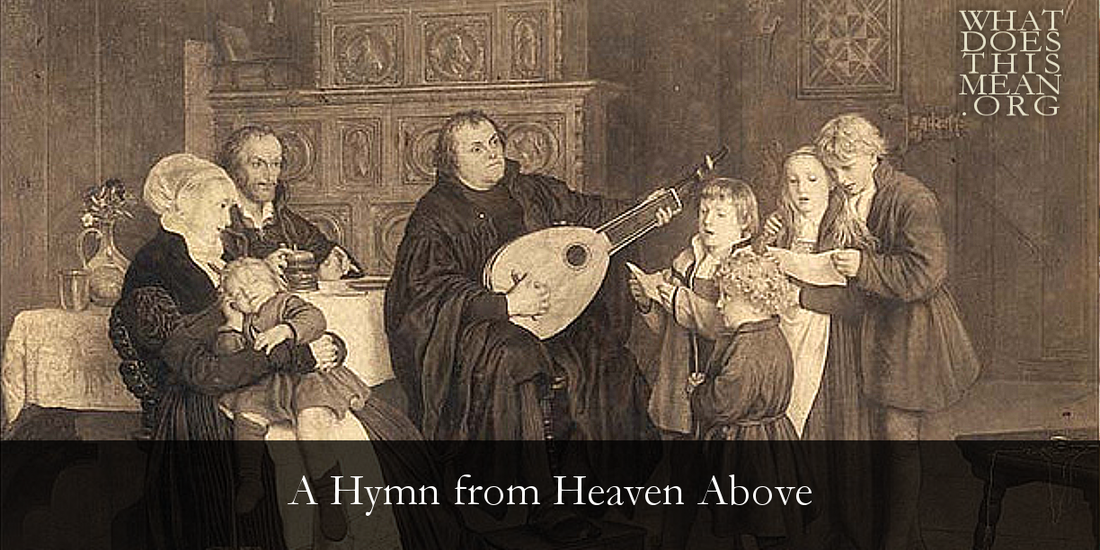Good news from far abroad I bring,
Glad tidings for you all I sing.
I bring so much you’d like to know
Much more than I shall tell you though (Luther’s Works, 53:289)
Luther’s text is based on the Christmas narrative in St. Luke 2:10-20, using the narration above as a starting point and unfolding the mysteries of the Christmas Gospel through 15 stanzas. The text was originally paired with a popular tune, also associated with the text cited above. Luther quickly realized, however, that the sacred text deserved its own tune, and he probably wrote the tune that we know today. The simple melody has become part of the core hymnody of confessional Lutheran orthodoxy; it is found set in the church music of J. S. Bach and other composers of the 16th, 17th, and 18th centuries. Three brief excerpts from the first two of the six cantatas that comprise Bach’s Christmas Oratorio highlight the rich treasures in Luther’s only original composition for Christmas.
***
Following a bass aria on the paradox that the Mighty Lord and King of all creation was born in a lowly manger, Bach set one stanza of Luther’s chorale in the “Trumpet Key” of D Major, with brass and timpani:
Ah, dearest Jesus, holy Child,
Prepare a bed, soft, undefiled,
A quiet chamber set apart
For You to dwell within my heart (LSB 358.13).
This musical setting is majestic, recalling the use of trumpets and timpani for themes such as the resurrection by Bach, and for the Coronation Anthems of his contemporary, George Fredrick Handel. But see how the regal music stands in contrast to the tender and child-like text, which preaches the good news that Jesus has prepared a chamber “within my heart.” The juxtaposition of music and text proclaims the great paradox of John’s Gospel: God will be glorified among His people, but not in the way we might expect. Rather, God will be glorified by becoming flesh, dwelling among us, and dying our death.
***
The second use of “From Heaven Above” in JSB’s Christmas Oratorio is a simple chorale, i.e., a German hymn in four parts:
Ah, Lord, though You created All,
How weak you are, so poor and small;
That You should choose to lay Your head
Where lowly cattle lately fed! (LSB 358.9)
This simple chorale, which stands in contrast to the complex music of the oratorio, allows the melody to predominate and highlights how the text and tune are a perfect fit for one another. The tune starts relatively high in the vocal register, depicting heaven on high (Himmel hoch) as the source of the angel’s glad tidings of great joy. The tune then meanders up and down until it finally arrives home, a full octave below the first note of the tune. This depicts the good news that God is quite literally down to earth in Christ.
***
At the end of the second portion of the Christmas Oratorio, Bach used a lilting, 12/8 meter with Luther’s tune set high in the vocal register. The text is a lesser known stanza of “We Sing, Immanuel, Thy Praise” by Paul Gerhardt:
In chorus now to Thee we raise
With mighty voice our songs of praise
That Thou our long awaited Guest
Hast come at last, beloved and blest.
The 12/8 meter (or two sets of 6/8), along with two pairs of two different types of oboes, is a musical form known as the Pastorale, which is fitting for the shepherds (pastores) in Luke 2. Moreover, the dotted rhythm is a rhythmic rocking motif, as if to beckon the shepherds to Bethlehem to find the Christ Child in the arms of His virgin mother, and to summon all the Faithful to come and adore Him.



 RSS Feed
RSS Feed
